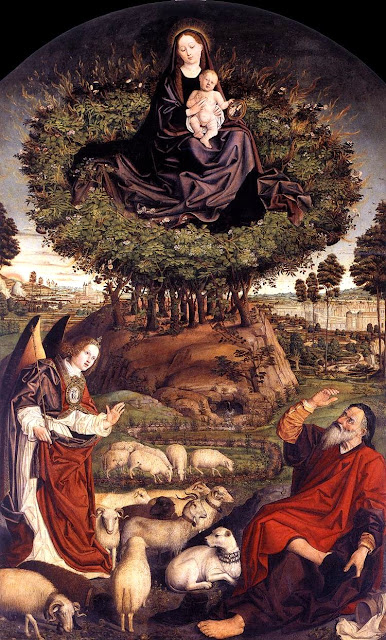_ca.%201270_Finding%20of%20Moses%20&%20Burning%20Bush_BNF_Latin%2010525,%20fol.29v_2.jpg) |
| +The Finding of Moses and Moses and the Burning Bush From the Psalter of St. Louis French (Paris), c. 1270 Paris, Bibliotheque Nationale de France MS Latin 10525, fol. 29v |
Yesterday, we began examining images that reflect the text of the so-called "O Antiphons" from Evening Prayer in the Liturgy of the Hours (also called the Divine Office) on the week preceding Christmas.
The text for December 18th is "O sacred Lord of ancient Israel, who showed yourself to Moses in the burning bush, who gave him the holy law on Sinai mountain: come, stretch out your mighty hand to set us free".
The text refers to the apparition of God to Moses in the bush that burned but was not consumed by the flames (Exodus 3 and 4). While nowadays we tend to imagine that the Presence which spoke to Moses out of the burning bush equates to God the Father, the term "God" actually includes all the Persons of the Trinity: Father, Son and Holy Spirit. And this is certainly what has been in the minds of the artists of the medieval period in their images of the burning bush.
Nearly every image of Moses and the Burning Bush that I have seen from the medieval period shows a figure easily identifiable as Christ appearing inside the bush. The crossed nimbus (halo) is a giveaway.
nd, interestingly (considering the Advent context of the O Antiphon quoted above), several images present the episode of the Burning Bush in direct apposition with the Annunciation or the Nativity. The apparition to Moses is here being equated with the visit of the angel Gabriel to Mary or the birth of Jesus.
 |
| +Workshop of the Boucicaut Master, Moses and the Burning Bush French (Ile-de-France), c. 1400 - 1424 New York, Pierpont Morgan Library and Museum MS M 394, fol. 41v |
nd, interestingly (considering the Advent context of the O Antiphon quoted above), several images present the episode of the Burning Bush in direct apposition with the Annunciation or the Nativity. The apparition to Moses is here being equated with the visit of the angel Gabriel to Mary or the birth of Jesus.
 |
| Annunciation with Moses and the Burning Bush From the Tres Belles Heures de Notre Dame de Jean de Berri Netherlandish, c. 1400 Turin, Museo Civico d'Arte Antica |
 |
| Nativity with Moses and the Burning Bush From the Hours of the Virgin French (Rouen), c. 1495-1505 New York, Pierpont Morgan Library and Museum MS M 129, fol. 35r |
In a sense, each of these events signals the beginning of a new phase in the relationship between God and humanity. For Moses and the people of Israel, the Burning Bush signals the beginning of their release from bondage and the giving of the Law of the Ten Commandments. For Christians, the new Israel, the Annunciation signals the entrance of Christ, the very Word of God, into our human condition and the beginning of a new Law of Love.
In addition, the bush itself, which burns but is not consumed by the flames, was seen as a reference to Mary who, while remaining a virgin, gives birth to Son of God.
One of the most astonishing images in this iconography is the central panel of an altarpiece painted by the French master, Nicolas Froment in 1476. It shows Moses, surrounded by his sheep and with his dog at his side, in the process of removing his shoes, as he was commanded. Beside him stands an angel, to whose presence Moses reacts with astonishment. This angel is dressed much as Gabriel is dressed in numerous 15th-century Netherlandish paintings, in a cope worn over an alb.
 |
| +Nicolas Froment, The Burning Bush French, 1476 Aix-en-Provence, Cathedral |
Even more astonishing is that the apparition in the burning bush is not of the adult Christ (as it is in other images) but is an apparition of the Madonna and Child. In this picture, the allusion to the Annunciation and Nativity so long paired with the Burning Bush, have become one image.
© M. Duffy, 2011. Selected images were refreshed in 2024.
+ Indicates a refreshed image.

No comments:
Post a Comment